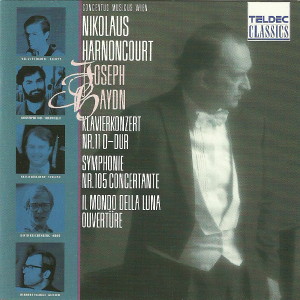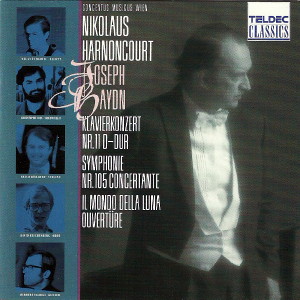 |
1 LP -
6.43674 AZ - (p) 1989
|
 |
| 1 CD -
8.43674 ZK - (p) 1989 |
|
| Franz Joseph
Haydn (1732-1809) |
|
|
|
|
|
|
|
Klavierkonzert Nr. 11 D-dur,
Hob. XVIII/11 *
|
|
20' 25" |
|
| - Vivace |
8' 54" |
|
A1 |
| - Un
poco Adagio |
6' 23" |
|
A2 |
- Rondo all'Ungherese.
Allegro assai
|
5' 08" |
|
A3 |
| Sinfonia (Ouvertũre) "Il
Mondo della Luna" C-dur, Hob. XXVIII/7 |
|
4' 08" |
|
| - Allegro |
4' 08" |
|
A4 |
Symphonie
Nr. 105 B-dur "Concerntante",
Hob. I/105 **
|
|
21' 49" |
|
- Allegro
|
9' 48" |
|
B1 |
| - Andante |
4' 55" |
|
B2 |
| - Allegretto con spirito |
7' 06" |
|
B3 |
|
|
|
|
Herbert
Tachezi, Klavier *
|
|
| David
Reichenberg, Oboe ** |
|
| Milan
Turković, Fagott ** |
|
| Erich
Höbarth, Violine ** |
|
| Christophe
Coin, Violoncello ** |
|
|
|
CONCENTUS
MUSICUS WIEN (mit
Originalinstrumenten)
|
|
| Nikolaus
Harnoncourt, Leitung |
|
|
Luogo
e data di registrazione
|
| Casino
Zögernitz, Vienna (Austria) - aprile
1987; maggio 1988 * |
|
Registrazione
live / studio
|
| studio |
Producer
/ Engineer
|
Wolfgang
Mohr / Helmut A. Mühle / Michael
Brammann
|
Prima Edizione CD
|
| Teldec
- 8.43674 ZK - (1 cd) - 46' 47" - (p)
1989 - DDD |
|
Prima
Edizione LP
|
Teldec - 6.43674
AZ - (1 lp) - 46'
47"
- (p) 1989 - Digital
|
|
|
Notes
|
Of the many concerti
HAYDN wrote for piano and orchestra or
piano and solo strings, the CONCERTO
IN D-MAJOR has always been
particularly popular. Whereas Haydn
based his first keyboard concerti, in
the 1760s, on the
harpsichord, the D major work, which
dates from 1781 at the latest. was
composed for the modern fortepiano,
and Haydn made full use of the
instrument's potential. The fortepiano
was already in an advanced stage of
development by this time,
and this is evident in Haydn’s
sophisticated treatment of arpeggio
figures and ot the plainly subordinate
accompaniment in the piano part. The
same applies to the integration of
wind instruments into the orchestra.
Like "alla turca"
passages in the works of various
composers, music of Hungarian
influence bears witness to national
colouring popular in the 18th century,
and this comes out in the melodics and
tempo of the “Rondo all’ungarese".
Sudden changes into the minor,
conspicuous ornamentation
and rhythms offered the opportunity
for varying types of expression in the
rondo, and for virtuoso display.
The opera "IL
MONDO DELLA LUNA" (The
world on the moon) after a comedy by
Carlo Goldonl was performed at the
wedding of Prince Niklas
Esterházy on 3rd
August 1777 in Eisenstadt, where Haydn
held the position of Kapellmeister at
the time. For the overture, Haydn used
the first movement of his Symphony no.
63, on which he was working
simultaneously, but he gave the piece
a different ending that was more
appropriate to the opera. Since
overtures did not always anticipate
the subject-matter
ofthe opera at this time - and this is
true of Haydn as well - Haydn only had
to devise introductory music of
suitable character for a “dramma
giocoso". This- although he was
always circumspect about re-using
music from his own works - he managed
to do with complete success.
Joseph Haydn was already a famous and
respected figure throughout Europe,
when he organized several series of
concerts together with the violinist
and impresario Johann
Peter Salomon in London in 1792. For
the concert on 9th March of that year,
Haydn composed the SINFONIA
CONCERTANTE for oboe, bassoon, violin,
cello and orchestra, the only work of
this kind that he wrote. In
the fusion of concerto and symphony
genres he had already accumulated
considerable experience, for
concertante elements occur in a number
of his symphonies. In the Sinfonia
concertante, the solo instruments also
play together with the orchestra in
the non-solo parts.
This means that two each of oboe and
bassoon are available in these
passages, while the accompanying parts
are allocated only one instrument
each; a device that enables the sound
to be made lighter or more dense.
Haydn’s sense of colour is also
evident in the make-up of the solo
quartet: the oboe and bassoon
correspond to the two string
instruments as woodwind instruments of
the same type. The chamber playing of
the quartet is combined with a
symphonic conception, in which the
three-movement form and virtuosity are
at the same time elements of the
concerto. Haydn’s melodies are
characterized by spacious lines that
offer room for filigree elaboration of
the solo parts and chamber-musical
interaction. In the finale Haydn has
some more surprises in store: the
beginning of the rondo theme, played
unison, is interrupted twice by adagio
recitatives on the solo violin, a
third one follows later in the
movement, and what appears to be the
music gradually drawing to a close in
fact leads back into the racy rondo
theme as the true ending. The première
was such a success - Salomon
himself played the solo violin part -
that the work was repeated only a week
later (!) in another Salomon concert.
Gerhard
Schuhmacher
Translation: Clive Williams
|
|
Nikolaus
Harnoncourt (1929-2016)
|

|

|
|